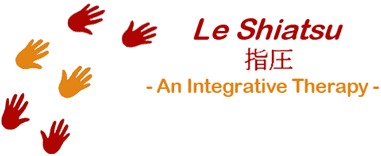- Western Principles
- Eastern Principles
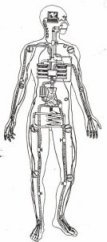
Western views:
the body as a machine
- from the book : "Between Heaven and Earth" by Beinfield & Korngold's
Western Medicine is beginning to recognize the value of acupuncture in areas such as pain reduction, for alleviating the side effects of chemotherapy, or to support recovery from surgery. Acupuncture does this in a gentle and non invasive way. But Acupuncture and Chinese Medicine are applied in reality to a much broader range of ailments.
There has been less research on Shiatsu, but this form of acupressure uses the same meridians and points on the body and is based on the same founding principles.
The actual physiological effect is not well understood yet. We can hypothesize that stimulating acu-points generates deep reactions within the body with nervous impulses, neurotransmitters, hormones and naturally occurring biochemical agents. Even though the exact mechanism is not well explained in Western physiology terms, the clinical impact is real. Significant improvement for a variety of functions have been observed: pain reduction, increased mental clarity, better circulation, relaxation, improved immunity, better digestion, enhanced locomotion etc.
We are introducing below three approaches from literature that attempt to explain the effect of acupuncture and acupressure: connective tissue planes, skin pressure sensors, and stimulation of the parasympathetic nervous response.
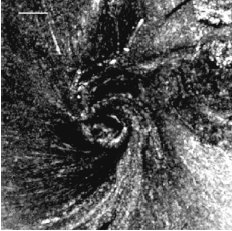
Ultrasound image showing the rearrangement of connective tissue: after needle insertion (from Konofagou & Langevin, "Using Ultrasound to Understand Acupuncture", IEEE Engineering in Medicine & Biology, March/April 2005)
Connective tissue planes:
Ultrasound images of an acu-point stimulated by a needle show a special rearrangement of the skin and tissue cells, in a whirled pattern. This rearrangement does not occur without the needle stimulation, or away from an acu-point. A model supported by animal and human experiments shows a rearrangement of connective tissues around an acupuncture needle inserted in the skin. The coupling of the needle and the tissue sends "mechanical signals" that can have powerful effects on the abundant cells (fibroblasts, immune cells), neural, vascular and lymphatic elements that lie in the same connective tissue plane. It has been found that there are planes of connective tissue that correspond to the acupuncture meridians.
Skin pressure sensors:
Another model is based on the fact that the body is covered with a multitude of skin sensors. These special nerve endings are sensitive to stimuli like heat, cold, pain, or pressure. Acu-points are likely located on pressure sensors. Changing the physiological environment of such a point by pressure creates a nervous stimulus called an Action Potential (AP). The AP travels in the nervous system like a little electrical current, and reaches the central nervous system. It may take precedence over pain stimuli, or it may directly trigger natural pain relieving reactions or other neuro-hormonal regulating mechanisms.
Stimulation of the parasympathetic nervous response:
The central nervous system has two branches. The sympathetic nervous system consists of nerve fibers that promote the fight & flight response when we are exposed to an alarming stimulus. The body is ready for immediate action with production of adrenaline and an increase in cellular activity, heart & respiratory rates, and blood flow to peripheral muscles. In such situations of emergency, functions that are not immediately needed for survival are shut or slowed down: digestion, immunity, or tissue repair. This is why chronic stress negatively affect the later functions. The other branch, the parasympathetic nervous system results in a state of relaxation and calmness prone to absorption of nutrients, tissue repair, stimulating immunity and recuperation.
In conclusion, it is believed that Shiatsu stimulates the parasympathetic systems which would explain why patients feel relaxed and energized at the same time, with increased mental clarity, improved immunity, reduction of pain and overall healing. Physically, Shiatsu finger pressure loosens tense connective tissues and muscles, promoting better local circulation. Muscle nourishment is improved and wastes can be eliminated, another factor reducing pain. Stretches improve joint flexibility and Shiatsu results in increased range of motion.
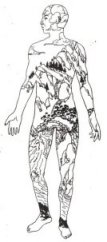
Eastern views:
the body as a garden
- from the book : "Between Heaven and Earth" by Beinfield & Korngold
The Eastern medical tradition looks at a person in relation with nature. Man is considered as a living-being between Earth (Yin aspect) and Heaven (Yang aspect).
Chi, Yin and Yang need to be in balance within the body. An unbalance can be explained by their excess or deficiency. But harmony between man and nature is also important.
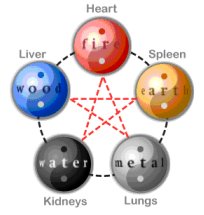
The five elements and their relations with the major Yin organs of Chinese medicine
Disharmonies in the body are actually described using an analogy with nature: a fever is considered as an excess of "Heat", a lump or arthritic swollen joint as an accumulation of "Dampness", a moving pain is a sign of "Wind" etc.
Ailments can be categorized according to the presence of Heat, Dampness, Dryness, Cold, and Wind, which are related to the "Five Elements" of nature: Fire, Earth, Metal, Water and Wind, respectively.
What may sound naive or esoteric at first, was patiently elaborated over thousands of years into a coherent system based on careful clinical observations. And it is staggering to see how well it correlates with what patients experience!
To have good vitality, a person needs to have proper digestion, locomotion, circulation, respiration etc. These functions were known to the ancient Eastern doctors and are performed by 12 internal organs (Lungs, Large Intestine, Stomach, Spleen, Heart, Small Intestine, Bladder, Kidneys, Pericardium, Triple Heater, Gall Bladder and Liver). In order to function well, organs need to have a balanced Chi, Yin, and Yang. They also need to have a solid constitution or genetic make-up (explained as their original "Essence" since genetics was unknown). Finally, each organ has an emotional role (think of expressions like "it broke my heart", "having the gall to do something challenging" etc.). An emotional situation or imbalance can distort the corresponding organ function, and vice versa the imbalance of an organ can result in certain emotional states.
All organs work in concert. Their energy or Chi is not only present in the organ itself, but it also flows along the Chi meridians. Each organ has its specific Chi-meridian flowing along a channel in the body. For example, the meridian of the Heart flows along the inside part of the arm. This seems empirically logical when we think of the pain radiating along the arm that people with a heart attack experience.
Acupuncture and acupressure use points along the Chi meridians to restore free Chi flow, and re-balance organs functions, promoting physical, mental and emotional well being.
Chi can be cultivated by breathing and gentle exercises such as Chi Kung, Tai-Chi, Yoga, or meditation. It can be influenced by herbal remedies, diet, exercise, sleep, behaviour and mental attitudes. Chi is directly affected by acupuncture/acupressure.
